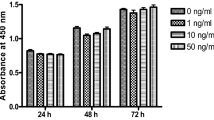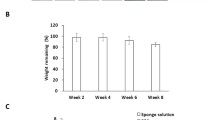Summary
A polypentapeptide (PPP) of tropoelastin having a repeating amino acid sequence of (Val-Pro-Gly-Val-Gly)n was evaluated for its potential to initiatein vivo calcification and to enhance bone formation in nonhealing calvarial wounds (8.0 mm) in 396 adult Walter Reed rats. There were four configurations of the PPP (molecular weight range of 50–100K dalton) consisting of 1-dry PPP; 2-co-acervate PPP; 3-gamma irradiated, cross-linked PPP; 4-calcified, gamma irradiated, cross-linked PPP. These four iterations plus a control group of animals constituted the five treatment classes that were evaluated at days 1, 3, 7, 21, 42, and 147. Seventy two rats were used for each treatment and 36 rats for the control. Following euthanatization, specimens were placed into 70% ethanol, embedded in polymethyl methacrylate, sectioned at 3.5 micrometers, and alternating sections were stained with Masson-Goldner trichrome and von Kossa stains.
Histomorphometric analysis was accomplished using a Zeiss Universal microscope (250×) and Videoplan Image Analysis System to evaluate five random histologic fields from margin to margin of the craniotomy. Trabecular bony volume and area of calcification islands were quantitated. A Student'st test for unpaired data to determine treatment differences (within the same temporal groups) revealed that there was no significant difference between treatments and control for trabecular bony volume; however, there was a significant difference between experimentals and control for calcification islands (P<0.05) such that calcifications islands for the experimentals were greater than the control. There was not a significant difference between experimental treatments. These data provide the firstin vivo demonstration of the validity of the neutral site binding/charge neutralization mechanism of calcification. Although the synthetic peptide did support calcification, in no group was new bone formed in the craniotomies.
Similar content being viewed by others
References
Gregory CF (1972) The current status of bone and joint transplants. Clin Orthop 87:165–175
Jarcho MD (1981) Calcium phosphate ceramics as hard tissue prosthetics. Clin Orthop 175:259–273
Hollinger JO, Battistone GC (1986) Biodegradable bone repair materials: synthetic polymers and ceramics. Clin Orthop 207:290–305
Harakas NK (1984) Demineralized bone matrix-induced osteogenesis. Clin Orthop 188:239–251
Hollinger JO (1982) In vivo calcification induced by a proteolipid complex (lysozyme-acidic phospholipid). Biomat Med Dev Art Org 10:71–83
Hollinger JO, Schmitz JP (1987) A biodegradable implant for restoring bone discontinuities in dogs. J Oral Maxillofac Surg 45:594–600
Urist MR, Lietze A, Dawson E (1984) Beta tricalcium phosphate delivery system for bone morphogenetic protein. Clin Orthop 187:277–280
Foster JA, Burenger E, Gray WR, Sandberg LB (1973) Isolation and amino acid sequences of tropoelastin peptides. J Biochem (Tokyo) 248:2876–2879
Sandberg LB, Soskel NT, Leslie LB (1981) Elastin structure, biosynthesis and relation to disease states.
Sandberg LB, Leslie LG, Leach CT, Alvarez VL, Torres AR, Smith DW (1985) Elastin covalent structure as determined by solid phase amino acid sequencing. Pathol Biol (Paris) 33:266–274
Urry DW, Long MM, Hendrix LF, Okamoto K (1976) Cross-linked polypentapeptide of tropoelastin: an insoluble, serum calcifiable matrix. Biochemistry 15:4089–4094
Starcher BC, Cox BA, Urry DW (1974) Development of an in vitro system for the calcification of tropoelastin and α-elastin coacervates in serum. Calcif Tissue Int 17:1–7
Cox BA, Starcher BC, Urry DW (1975) Scanning electron microscopy and electron probe microanalysis of calcified α-elastin coacervates. Calcif Tissue Int 17:219–227
Urry DW, Hendrix CF, Long MM (1976) Calcification of α-elastin coacervates: a bulk property of elastin. Calif Tissue Int 21:57–65
Urry DW, Long MM, Okamoto K, Volpin D, Roveni N, Ripamonti A (1977) Synthetic polypeptide matrix induces apatite formation when exposed to serum diffusate. Ala J Med Sci 14:255–258
Urry DW, Prasad KU (1985) Syntheses, characterizations and medical uses of the polypentapeptide of elastin and its analogs. In: Williams DF (ed) Biocompatibility of tissue analogs. CRC Press, Inc, Boca Raton, Florida, pp 89–116
Prasad KU, Iqbal MA, Urry DW (1985) Utilization of I-hydroxybenzotiazole in mixed anhydride coupling reactions. Int J Peptide Protein Res 25:408–413
Wood SA, Lemons JE, Prasad KU, Urry DW (1986) In vitro calcification and in vivo biocompatibility of the cross-linked polypentapeptide of elastin. J Biomed Mater Res 20:315–335
Poser JW, Esch FS, Ling NC, Price PA (1980) Isolation and sequence of the vitamin K-dependent protein from human bone. J Biol Chem 255:8685–8691
Wuthier R (1982) A review of the primary mechanism of endochondral calcification with special emphasis on the role of cells, mitochondria, and matrix vesicles. Clin Orthop 169:219–242
Urry DW (1971) Neutral sites for calcium ion binding to elastin and collagen: a charge neutralization theory for calcification and its relationship to arteriosclerosis. Proc Nat Acad Sci USA 68:810–814
Wells HA (1933) The chemistry of arteriosclerosis. In: Cowdry EV (ed) Arteriosclerosis: a survey of the problem. McMillan, New York, 323–353
Starcher BC, Saccomani G, Urry DW (1973) Coacervation and ion-binding studies on aortic elastin. Biochim Biophys Acta 310:481–486
Kagan HM, Lerch RM (1976) Amidated carboxyl groups in elastin. Biochim Biophy Acta 434(1):223–232
Schmitz JP, Hollinger JO (1986) The critical size defect as an experimental model for craniomaxillofacial nonunions. Clin Orthop 205:299–308
Stevens A, Cogen R, Urry DW, Long MM (1981) Effect of a calcifiable matrix on human cell viability. J Dent Res 61:391
Waikakul A, Cogen R, Stevens A, Urry DW, Long MM (1982) Effect of a calcifiable matrix on human cells. J Dent Res 61:189
Waikakul A (1983) Effect of a calcifiable matrix on human cells. M Sc thesis, University of Alabama in Birmingham
Wood SA, Prasad KU, Urry DW (1985) Cross-linked polypentapeptide of elastin as a calcifiable matrix: molecular weight dependence. Calcif Tissue Int 37:565–571
Mundy GR, Poser LW (1983) Chemotactic activity of the γ-carboxyglutamic acid containing protein in bone. Calcif Tissue Int 35:164–168
Majeska RL, Rodan SB, Rodan GA (1980) Parathyroid hormone responsive clonal cell lines from rat osteosarcoma. Endocrinology 107:1494
Majeska RJ, Rodan SB, Rodan GA (1980) Parathyroid hormone responsive clonal cell lines from rat osteosarcoma. Endocrinology 107:1494
Author information
Authors and Affiliations
Additional information
Commercial materials and equipment are identified in this report to specify the investigative procedure. Such identification does not imply recommendation or endorsement, or that the materials and equipment are necessarily the best available for the purpose. Furthermore, the opinions expressed here are those of the authors and are not to be construed as those of the Army Medical Department. In conducting research described in this report, the investigators adhered to the “Guide for the Care and Use of Laboratory Animals” as promulgated by the Committee on the Revision of the Guide for Laboratory Animal Facilities and Care of the Institute of Laboratory Animal Resources National Research Council.
Rights and permissions
About this article
Cite this article
Hollinger, J.O., Schmitz, J.P., Yaskovich, R. et al. A synthetic polypentapeptide of elastin for initiating calcification. Calcif Tissue Int 42, 231–236 (1988). https://doi.org/10.1007/BF02553748
Received:
Revised:
Issue Date:
DOI: https://doi.org/10.1007/BF02553748




